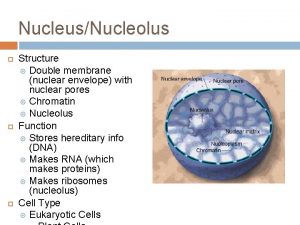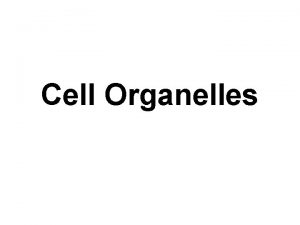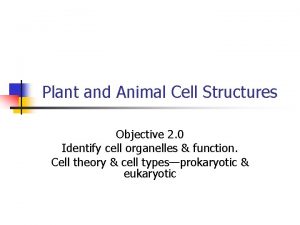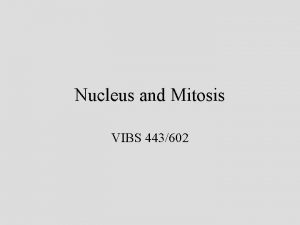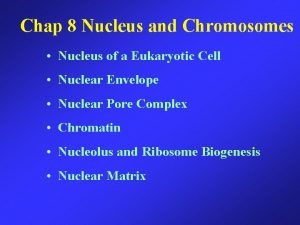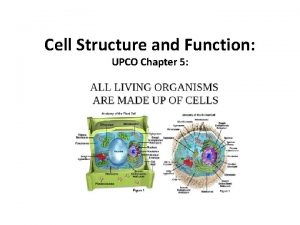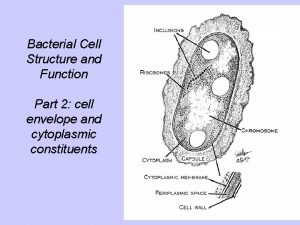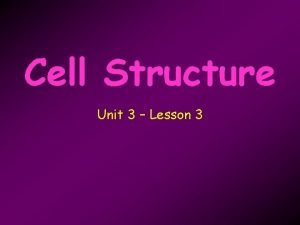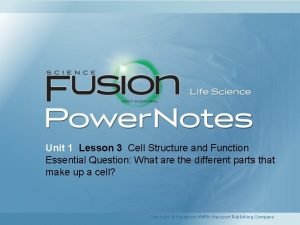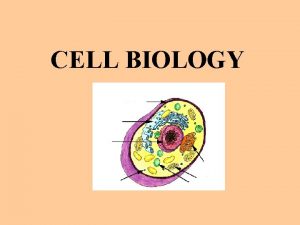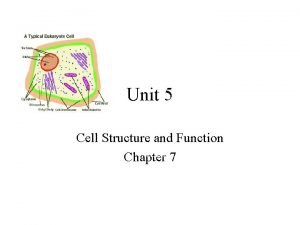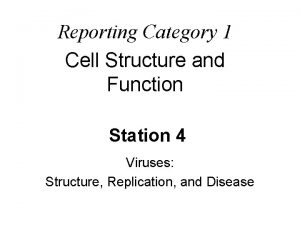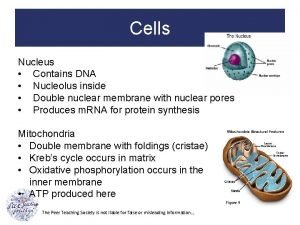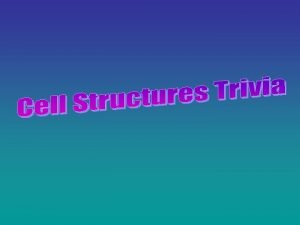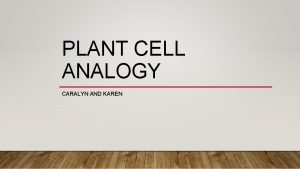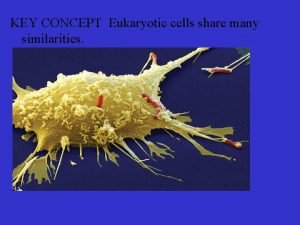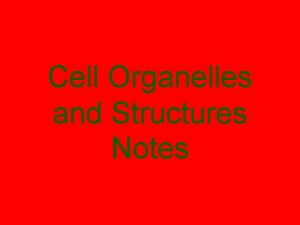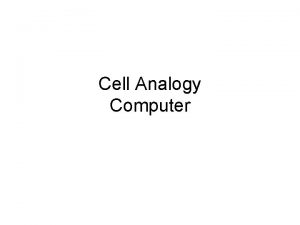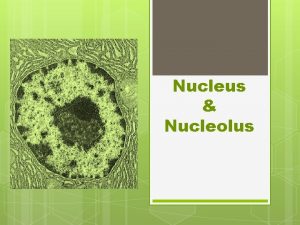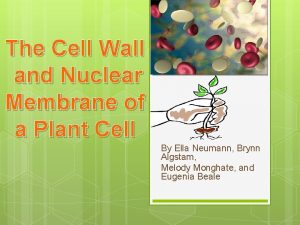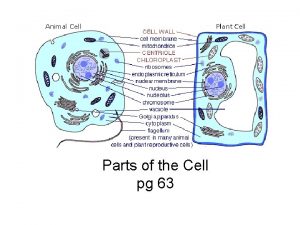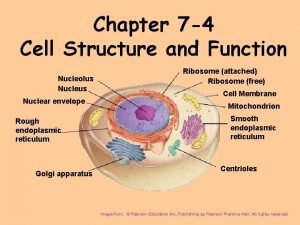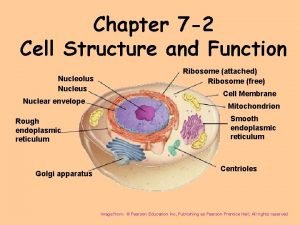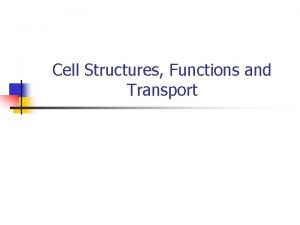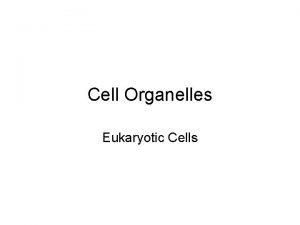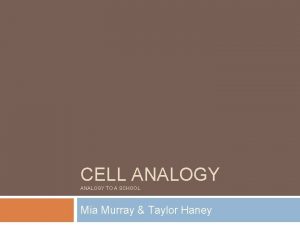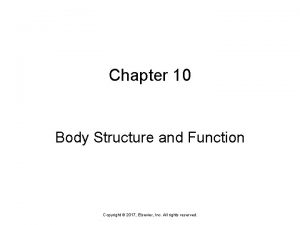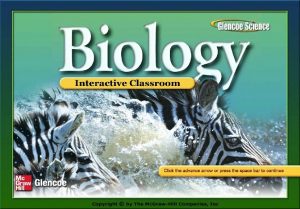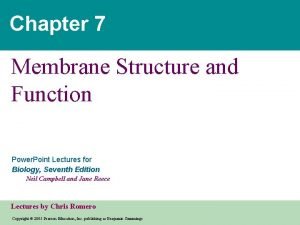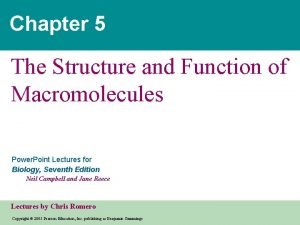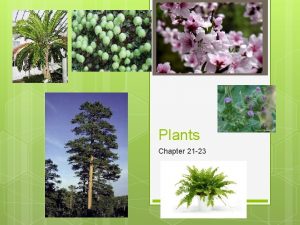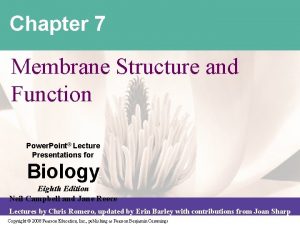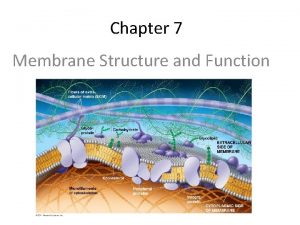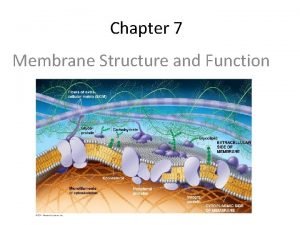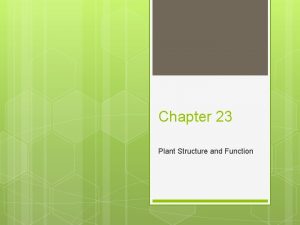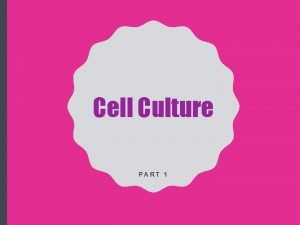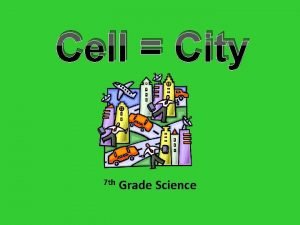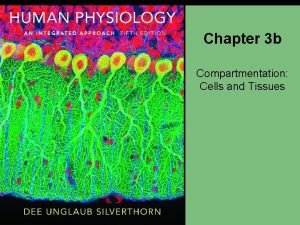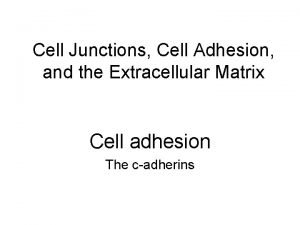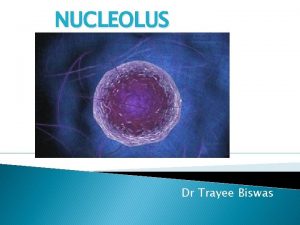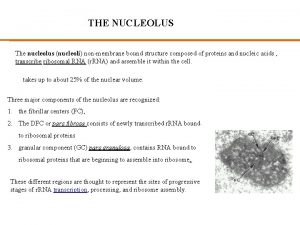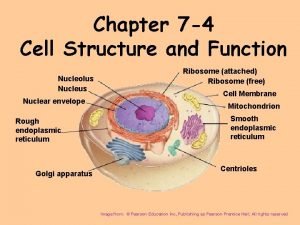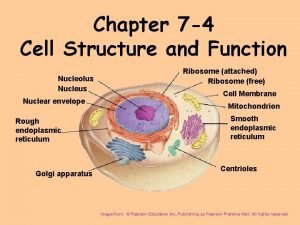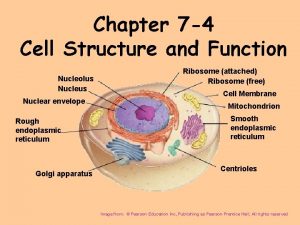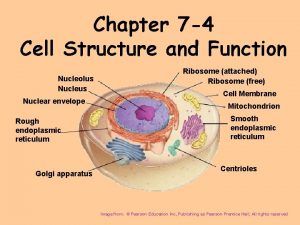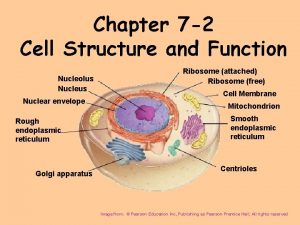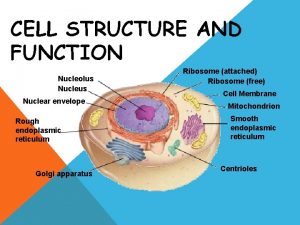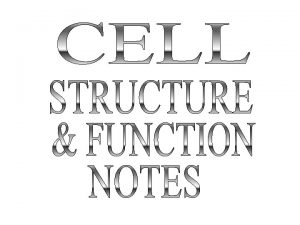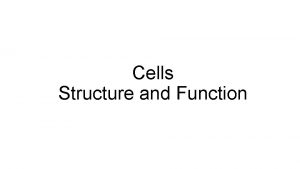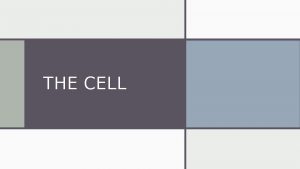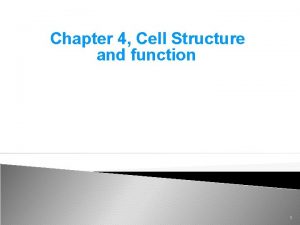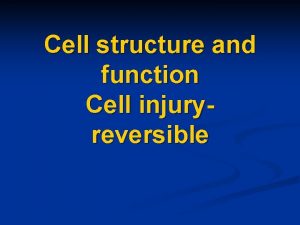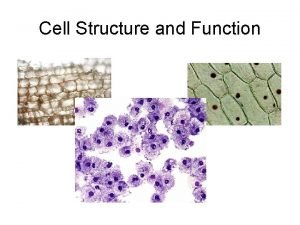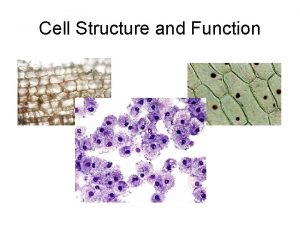Chapter 7 2 Cell Structure and Function Nucleolus











































































- Slides: 75

Chapter 7 -2 Cell Structure and Function Nucleolus Nuclear envelope Rough endoplasmic reticulum Golgi apparatus Ribosome (attached) Ribosome (free) Cell Membrane Mitochondrion Smooth endoplasmic reticulum Centrioles Image from: © Pearson Education Inc, Publishing as Pearson Prentice Hall; All rights reserved

A CELL is. . . Image from: http: //www. biology 4 kids. com/files/cell_membrane. html made of MOLECULES ATOMS ______ MOLECULES ORGANELLES ___________

CELL THEORY CELL SIZE Cells 1. All living things are made of _______. 2. Cells are the basic unit of structure & function in an organism (= basic unit of _____) life existing 3. New cells are produced from _________ cells PLANT ANIMAL cells > _______ BACTERIA ______ cells > _____

ALL LIVING THINGS ARE MADE OF CELLS Cells _____ WITHOUT a NUCLEUS _______ OR ORGANELLES surrounded MEMBRANES by ________ WITH Cells _____ a NUCLEUS AND ORGANELLES surrounded by MEMBRANES PROKARYOTES = ________ EUKARYOTES = _________ Bacterial Cell http: //www. earthlife. net/prokaryotes/welcome. html http: //summit. k 12. co. us/schools/shs/computer/tkelley/types. html

CELL MEMBRANE (also called plasma membrane) Cell membranes are made mainly of ________ PHOSPHOLIPIDS & _________ PROTEINS Outside of cell Proteins Carbohydrate chains Cell membrane Inside of cell (cytoplasm) Protein channel Lipid bilayer Image from: © Pearson Education Inc, Publishing as Pearson Prentice Hall; All rights reserved

LIPID TAILS ARE HYDROPHOBIC HYDROPHILIC HYDROPHOBIC Image by Riedell

Oil and water don’t mix! Image from: http: //employees. csbsju. edu/hjakubowski/classes/ch 112/lipids/micbilayer. gif

PHOSPHOLIPID BILAYER SEE HOW MEMBRANES FORM Image from: http: //employees. csbsju. edu/hjakubowski/classes/ch 112/lipids/micbilayer. gif

CELL MEMBRANE Proteins that stick on the surface = (either inside or outside of cell) PERIPHERAL _______ INTEGRAL Proteins that stick INTO membrane = ________ (can go part way in or all the way through)

GLYCOPROTEINS Recognize “self” GLYCOPROTEINS are PROTEINS with carbohydrates attached Image from: http: //faculty. clintoncc. suny. edu/faculty/Michael. Gregory/files/Bio%20101%20 Lectures/Membranes/membrane. htm

TRANSPORT PROTEINS help move substances across the cell membrane http: //www 2. uic. edu/~myilma 1/ionchannel. gif Animations from: http: //bio. winona. edu/berg/ANIMTNS/facdifan. gif More on this in Chapter 7 -3

WHAT DOES IT DO? Images from: http: //vilenski. org/science/safari/cellstructure/cellmembrane. html http: //www. mccc. edu/~chorba/celldiagram. htm Acts as a boundary Controls what enters and leaves cell

Cell membranes MOVE! Animation from: http: //www. sp. uconn. edu/~terry/images/anim/fluidmem. gif Click here to see Fluidity Animation Molecules in cell membranes are constantly moving and changing

CYTOPLASM (Between nucleus and cell membrane) Image from: http: //vilenski. org/science/safari/cellstructure/cytoplasm. html Organelles suspended in gel-like goo ORGANELLEsmall structure with a specific function (job) Image from: http: //faculty. stcc. tn. us/jiwilliams/labprojectsmenu. htm

CELL MEMBRANE (PLASMA MEMBRANE) phospholipids proteins Made mainly of __________ and _________ HYDROPHOBIC “tails” of phospholipids make molecules line up as out & LIPID ________ with POLAR heads facing _______ BILAYER NON-POLAR tails facing ____ in MEMBRANE PROTEINS PERIPHERAL • __________stick on inside or outside surface • __________go part way or all the way through INTEGRAL GLYCOPROTEINS - recognize “self” • _________ TRANSPORT • ________ PROTEINS- move molecules across membrane FUNCTION: SELECTIVELY PERMEABLE Membranes are _________________ (=Semi-permeable) Allow certain molecules to pass through; but keep others out CONTROLS ______ what enters & leaves cell HOMEOSTASIS Helps with _________ cytoplasm _________ = gel-like material + organelles between nucleus and cell membrane

NUCLEUS Largest organelle in animal cells Image from: http: //www. mccc. edu/~chorba/celldiagram. htm

NUCLEUS Surrounded by NUCLEAR ENVELOPE (also called NUCLEAR MEMBRANE) DOUBLE MEMBRANE Image from: http: //www. agen. ufl. edu/~chyn/age 2062/lect_06/5_11. GIF

NUCLEUS NUCLEAR PORES Openings to allow molecules to move in and out of nucleus Image from: http: //www. emc. maricopa. edu/faculty/farabee/BIOBK/Bio. Book. CELL 2. html

WHAT DOES IT DO? Contains genetic material (DNA) DNA is scrunched up as CHOMATIN in NON-dividing cells DNA is spread out as CHROMOSOMES in dividing cells

WHAT DOES IT DO? Control center of cell Image from: Genetic code tells the cell’s parts what to do Image from: http: //web. jjay. cuny. edu/~acarpi/NSC/12 -dna. htm

NUCLEOLUS Image from: http: //lifesci. rutgers. edu/~babiarz/histo/cell/nuc 3 L. jpg Dark spot in nucleus = NUCLEOLUS _____ Makes RNA for ribosomes

NUCLEUS NUCLEOLUS Surrounded by _______ DOUBLE MEMBRANE called the NUCLEAR _________ ENVELOPE ______ CONTROL CENTER OF CELL Nuclear ______ PORES allow molecules in & out CONTAINS CELL’S GENETIC MATERIAL (_______) DNA Dark spot = NUCLEOLUS makes __________ (RNA) RIBOSOMES DNA is SPREAD OUT as CHROMOSOMES _______ in dividing cells. CHROMATIN DNA SCRUNCHED as ________ in non-dividing cells.

CYTOSKELETON Image from: http: //anthro. palomar. edu/animal/default. htm • Helps cell maintain shape • Help move organelles around Made of PROTEINS: MICROFILAMENTS (Actin) & MICROTUBULES (Tubulin) Image from: © Pearson Education Inc, Publishing as Pearson Prentice Hall; All rights reserved

CYTOSKELETON Made of PROTEINS called _______ MICROTUBULES& _________ MICROFILAMENTS cell maintain shape; FUNCTION: Helps _____________ Support; Helps in movement __________________

CENTRIOLES Appear during cell division to pull chromosomes apart

CENTRIOLES/MITOTIC SPINDLE Made of MICROTUBULES (Tubulin) Image from: http: //www. coleharbourhigh. ednet. ns. ca/library/organelle_worksheet. htm

CENTRIOLES MICROTUBULES Made of _____________ ANIMAL Only seen in ________ cells during cell division Pull chromosomes apart; Function: _________________

MITOCHONDRION (plural=MITOCHONDRIA) Look like “little sausages” Image from: http: //instructional 1. calstatela. edu/dfrankl/CURR/kin 150/Images/mitochondria. jpg

MITOCHONDRIA Surrounded by a DOUBLE membrane Has its own DNA Folded inner membrane increases surface area for more chemical reactions Image from: http: //www. biologyclass. net/mitochondria. jpe

MITOCHONDRIA Come from cytoplasm in EGG You inherit your mitochondria from your mother! http: //www. wappingersschools. org/RCK/staff/teacherhp/johnson/visualvocab/p 14%5 b 1%5 d. jpg

WHAT DOES IT DO? Images from: http: //vilenski. org/science/safari/cellstructure/mito. html http: //www. estrellamountain. edu/faculty/farabee/biobk/Bio. Book. CHEM 2. html “Powerplant of cell” Burns glucose to release energy Stores energy as ATP Image by: Riedell

MITOCHONDRION (pl. MITOCHONDRIA) DOUBLE Surrounded by _______ membrane Contains its own ______ DNA Power plant ________ of cell GLUCOSE Burns ______ ATP Stores energy released as ______ CRISTAE Folded inner membrane = _________ (increases surface area for more chemical reactions)

RIBOSOMES • Made of PROTEINS and RNA • Protein factory for cell Join amino acids to make proteins Image by: RIedell Image from: http: //www. ust. hk/roundtable/hi-tech. series/1_b 1. jpg

RIBOSOMES Image from: http: //www. biologyclass. net/endoplasmic. jpe Can be attached to Rough ER OR free in cytoplasm Image from: http: //www. mccc. edu/~chorba/celldiagram. htm

RIBOSOMES FREE in cytoplasm or ATTACHED Can be _________ to Rough ER PROTEINS RNA MADE OF _______ & ____ MAKE PROTEINS FUNCTION: ___________

ENDOPLASMIC RETICULUM Network of hollow membrane tubules 2 KINDS: SMOOTH or ROUGH Image from: http: //www. agen. ufl. edu/~chyn/age 2062/lect_06/5_10 B. GIF

ROUGH ENDOPLASMIC RETICULUM (Rough ER) Animation from: http: //vilenski. org/science/safari/cellstructure/er. html Makes membrane proteins and proteins for export out of cell Image from: http: //www. biologyclass. net/endoplasmic. jpe

ROUGH ENDOPLASMIC RETICULUM (ER) • Has RIBOSOMES attached • Proteins are made on ribosomes and inserted into Rough ER to be modified and transported Image from: http: //fig. cox. miami. edu/~cmallery/150/cells/ER. jpg

SMOOTH ENDOPLASMIC RETICULUM (smooth ER) Image from: http: //www. science. siu. edu/plant-biology/PLB 117/JPEGs%20 CD/0073. JPG • Has NO ribosomes attached • Has enzymes for special tasks

SMOOTH ENDOPLASMIC RETICULUM (smooth ER) Image from: http: //www. accs. net/users/kriel/chapter%20 eight/smooth%20 er. gif • Makes membrane lipids (steroids) • Regulates calcium (muscle cells) • Destroys toxic substances (Liver)

ENDOPLASMIC RETICULUM MEMBRANES Internal Network of __________ Rough ER: PROTEINS Attached ribosomes make _________ which are modified and transported to Golgi SMOOTH ER for export ROUGH ER (with ribosomes) (no ribosomes) Smooth ER: STEROIDS Makes membrane lipids (_________) CALCIUM Regulates ________ in muscles TOXINS Breaks down _________ in liver

GOLGI APPARATUS (BODY) Image from: http: //vilenski. org/science/safari/cellstructure/golgi. h Image from: http: //www. rsbs. anu. edu • Pancake like membrane stacks Modify, sort, & package molecules from ER for storage OR transport out of cell Image from: http: //vilenski. org/science/safari/cellstructure/golgi. h

Animation from: http: //www. franklincollege. edu/bioweb/A&Pfiles/week 04. html See a Golgi movie

GOLGI APPARATUS (BODY) Looks like a “___________” stack of pancakes membranes Made of ___________ FUNCTION: Modify, sort, & package substances storage from ER for _______ or export ________ out of cell

It’s ALL connected!

LYSOSOMES Animation from: http: //vilenski. org/science/safari/cellstructure/lysosomes. html Membrane bound sacs that contain PROTEINS called digestive enzymes Digest food, unwanted molecules, old organelles, cells, bacteria, etc

LYSOSOMES See lysosomes in action: Image modified from: http: //www. people. virginia. edu/~rjh 9 u/lysosome. html

LYSOSOMES See LYSOSOME MOVIE Image from: http: //www. people. virginia. edu/~rjh 9 u/lysosome. html

“PROGRAMMED CELL DEATH” APOPTOSIS = ___________ Lysosomes help digest unwanted cells http: //www. mgm. ufl. edu/images/bharfe/image 3. jpg http: //research. yale. edu/ysm/images/78. 3/articles-apoptosis-cells. jpg

Apoptosis plays a role in: Embryonic development Normal body cell maintenance Immune system responses Cancer AIDS infection Transplant rejection http: //www. cellsalive. com/apop. htm

LYSOSOMES Digestive enzymes Sac containing _____________ FUNCTION: food molecules & unwanted cells/cell parts; Digests _________________ APOPTOSIS Plays a role in ______“Programmed cell death” Cell suicide for the good of the organism

FLAGELLA & CILIA Made of PROTEINS called MICROTUBULES (9 + 2 arrangement) Image from: http: //www. stchs. org/science/courses/sbioa/metenergy/flagella. jpg

FLAGELLA Help in cell movement

CILIA Animation from: http: //web. jjay. cuny. edu/~acarpi/NSC/13 -cells. htm Move cell itself

CILIA Move substances past cells http: //www. sk. lung. ca/content. cfm? edit_realword=hwbreathe

WHAT’S THE DIFFERENCE? CILIA • Many • short FLAGELLA Animation from: http: //web. jjay. cuny. edu/~acarpi/NSC/13 -cells. htm • Few • Long

CILIA & FLAGELLA MICROTUBULES Made of PROTEINS called ________ 9 + 2 organized in a _____ arrangement that help with __________ MOVEMENT MANY SHORT CILIA =____ & _____ move cells; FUNCTION: ___________ move substances past cells ________________ FEW & ____ LONG FLAGELLA =______ Move cells FUNCTION: _________

WHAT’S SPECIAL ABOUT PLANT CELLS? • • Cell wall HUGE vacuoles Chloroplasts No centrioles

CELL WALL http: //www. windows. ucar. edu/kids_space/images/brick_wall. jpg Supports and protects cell http: //web. jjay. cuny. edu/~acarpi/NSC/13 -cells. htm Outside of cell membrane Made of carbohydrates & proteins CELLULOSE Plant cell walls are mainly _______

CELL WALL Cell membrane Found OUTSIDE the __________ Provides ______ & ________ SUPPORT PROTECTION CELLULOSE __________ makes plant cells sturdy PEPTIDOGLYCAN Bacteria have cell walls made of ________ instead.

VACUOLES Image from: http: //www. biologycorner. com/resources/plant_cell. gif Storage space http: //library. thinkquest. org/3564/Cells/cell 93. gif

VACUOLES Image from: http: //www. metoliusfriends. org/csca/images/tupperware. jpg • Storage space for WATER, salts, proteins (enzymes), carbohydrates, and waste Vacuoles SMALL in ANIMAL CELLS NO VACUOLES IN BACTERIA

Contractile vacuoles control excess water in cells (HOMEOSTASIS) http: //www. microscopy-uk. org. uk/mag/imgjun 99/vidjun 1. gif 1

VACUOLES carbohydrates, Storage space for: Proteins, ________ water, waste plant Huge in _____cells , animal small in _______ cells, bacteria Not in _________

CHLOROPLASTS http: //www. seorf. ohiou. edu/~tstork/compass. rose/photosynthesis/chloro_sun_bathing. gif • Use energy from sunlight to make own food (glucose) http: //stallion. abac. peachnet. edu/sm/kmccrae/BIOL 2050/Ch 1 -13/Jpeg. Art 1 -13/04 jpeg/04 -28_chloroplasts_1. jpg

CHLOROPLASTS http: //media. pearsoncmg. com/bc/bc_campbell_essentials_2/cipl/04/HTML/source/04 -17 -chloroplast-nl. htm • Surrounded by DOUBLE membran • Thylakoid membrane sacs contain enzymes for photosynthesis • Contains own DNA

CHLOROPLAST DOUBLE Surrounded by ______ membrane Has own ____ DNA THYLAKOIDS =membrane sacs inside _______ Contain CHLOROPHYLL where ____________ happens PHOTOSYNTHESIS PLANT FOUND ONLY IN _______ CELLS

Figure 7 -5 Plant and Animal Cells Section 7 -2 Smooth endoplasmic reticulum Vacuole Ribosome (free) Chloroplast Ribosome (attached) Cell Membrane Nuclear envelope Cell wall Nucleolus Golgi apparatus Nucleus Mitochondrion Rough endoplasmic reticulum Plant Cell Go to Section:

WHAT’S DIFFERENT ABOUT BACTERIAL CELLS? • Cell wall • NO NUCLEAR MEMBRANE • DNA is circular • No membrane bound organelles http: //www. eurekascience. com/ICan. Do. That/bacteria_cells. htm

BACTERIA have a CELL WALL BUT… Image from: http: //micro. magnet. fsu. edu/cells/procaryotes/images/procaryote. jpg IT’S MADE OF DIFFERENT MOLECULES than plant cell walls! PEPTIDOGLYCAN ________ NOT CELLULOSE! More on this in Chapter 18!

WHICH IS BIGGER? Plant cell Animal cell bacteria _________ > ___________

DIFFERENCES IN ANIMAL CELLS, PLANT CELLS, AND BACTERIA ANIMAL CELL PLANT CELL BACTERIA Eukaryotes Prokaryotes Cell membrane Nuclear membrane NO cell wall Cell wall made of CELLULOSE Cell wall made of PEPTIDOGLYCAN Has ribosomes DNA in multiple chromosomes DNA is a single circular ring CYTOSKELETON Small vacuoles Really big vacuole NO vacuoles Has lysosomes NO lysosomes Has centrioles NO chloroplasts Chloroplasts NO chloroplasts SMALLER SMALLEST NO nuclear membrane

No membrane bound organelles BACTERIA are PROKARYOTES Organelles with membranes PLANTS & ANIMALS are EUKARYOTES

USE WORDS FROM THE WORD BANKS TO COMPLETE THE VENN DIAGRAM COMPARISON

POWER POINT BY K. RIEDELL • ADAPTED FOR MISSISSIPPI STATE SCIENCE BENCHMARKS
 Vacuole function
Vacuole function Double membrane nuclear envelope
Double membrane nuclear envelope What happens if the nucleolus malfunctions
What happens if the nucleolus malfunctions Endoplasmic reticulum analogy
Endoplasmic reticulum analogy Cell structure diagram
Cell structure diagram Pancreas
Pancreas Structure of nucleolus
Structure of nucleolus Nuclear envelope
Nuclear envelope Biology chapter 7 cell structure and function
Biology chapter 7 cell structure and function Chapter 7 cell structure and function section review 7-2
Chapter 7 cell structure and function section review 7-2 Chapter 5 cell structure and function
Chapter 5 cell structure and function Middle lamella
Middle lamella Chapter 4 cell theory and cell study
Chapter 4 cell theory and cell study What is part 2
What is part 2 Lesson 3 cell structure and function answer key
Lesson 3 cell structure and function answer key Cell structure and function organizer
Cell structure and function organizer Lesson 3 cell structure and function answer key
Lesson 3 cell structure and function answer key Organelle graphic organizer answer key
Organelle graphic organizer answer key Cell structure and function
Cell structure and function Unit 5 cell structure and function answer key
Unit 5 cell structure and function answer key Category 1 cell structure and function
Category 1 cell structure and function Category 1 cell structure and function
Category 1 cell structure and function Category 1 cell structure and function
Category 1 cell structure and function Atp-adp cycle
Atp-adp cycle Preparation of protein molecules for cellular exportation
Preparation of protein molecules for cellular exportation Nucleolus nickname
Nucleolus nickname Analogy of a plant cell
Analogy of a plant cell Food vacuole
Food vacuole Golgi apparatus nickname
Golgi apparatus nickname Computer cell analogy
Computer cell analogy Who discovered nucleolus
Who discovered nucleolus Nuclear membrane
Nuclear membrane Nucleolus nickname
Nucleolus nickname The nucleolus __________.
The nucleolus __________. Endoplasmic reticulum function in plant cell
Endoplasmic reticulum function in plant cell Nickname for chloroplast
Nickname for chloroplast Nucleolus analogy
Nucleolus analogy Cell analogy of a school
Cell analogy of a school Denuding tower
Denuding tower Prokaryotic
Prokaryotic Plant cell outline
Plant cell outline Tonoplast
Tonoplast Primary and secondary cells
Primary and secondary cells Difference between plant cell and bacterial cell
Difference between plant cell and bacterial cell Section 10-2 cell division
Section 10-2 cell division Life
Life Idealized animal cell
Idealized animal cell Walker cell and hadley cell
Walker cell and hadley cell Cell cycle and cell division
Cell cycle and cell division Plant cell animal cell venn diagram
Plant cell animal cell venn diagram Phases of cell cycle
Phases of cell cycle Difference between galvanic cell and electrolytic cell
Difference between galvanic cell and electrolytic cell What is the gooey liquid in plant and animal cells
What is the gooey liquid in plant and animal cells Chapter 10 body structure and function
Chapter 10 body structure and function Chapter 22 plant structure and function answer key
Chapter 22 plant structure and function answer key Chapter 7 membrane structure and function
Chapter 7 membrane structure and function Chapter 5 the structure and function of macromolecules
Chapter 5 the structure and function of macromolecules Chapter 21 plant structure and function
Chapter 21 plant structure and function Chapter 7 membrane structure and function
Chapter 7 membrane structure and function Cell membrane polar head
Cell membrane polar head Chapter 7 membrane structure and function
Chapter 7 membrane structure and function Section 23-4 leaves
Section 23-4 leaves Cell city analogy project
Cell city analogy project Prokaryotic vs eukaryotic cell
Prokaryotic vs eukaryotic cell Electrochemical cell vs galvanic cell
Electrochemical cell vs galvanic cell Dry cell vs wet cell
Dry cell vs wet cell Cell wall vs cell membrane
Cell wall vs cell membrane Cell line vs cell strain
Cell line vs cell strain Cell line vs cell strain
Cell line vs cell strain Cell city project
Cell city project Cell-cell junction
Cell-cell junction Cell-cell junction
Cell-cell junction Which organelle prepares proteins for specific jobs
Which organelle prepares proteins for specific jobs Carbohydrate side chain
Carbohydrate side chain Is bacteria prokaryotic or eukaryotic
Is bacteria prokaryotic or eukaryotic Biology.arizona.edu/cell bio/activities/cell cycle/01.html
Biology.arizona.edu/cell bio/activities/cell cycle/01.html

